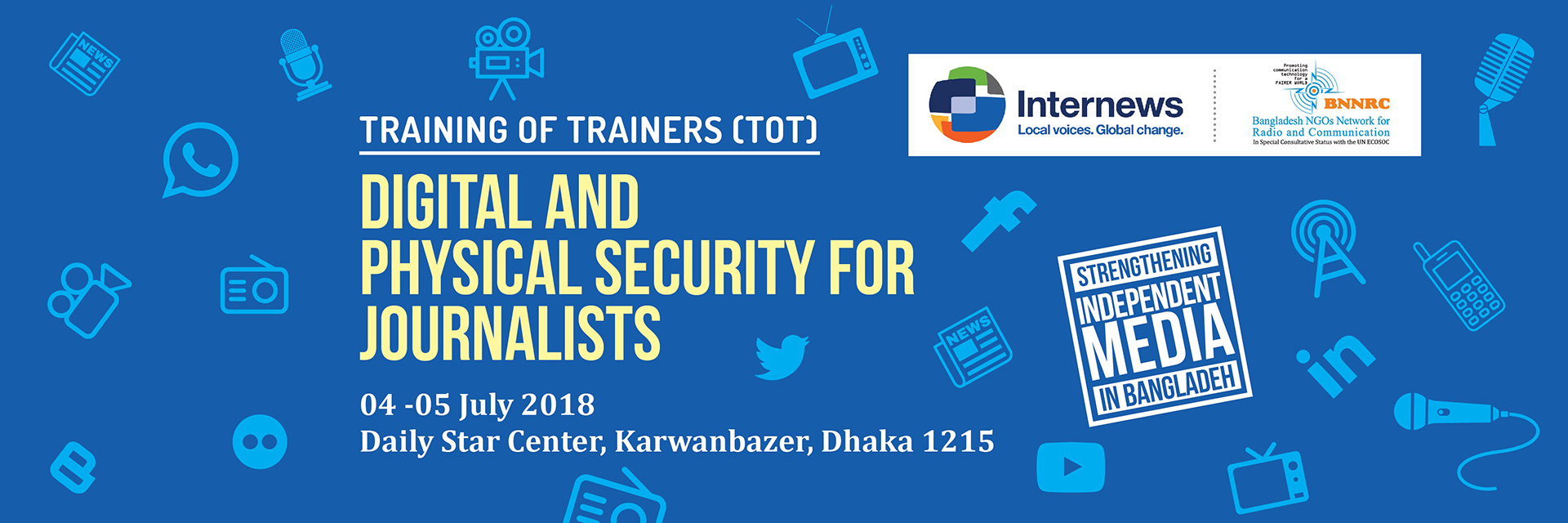DIGITAL SAFETY AND SECURITY FOR JOURNALISTS
A two-day course for media professionals organized by Bangladesh NGOs Network for Radio and Communication(BNNRC) with support from Internews
Do journalists need Digital Security?
Journalists depend on the Internet and digital communications for research on stories, interaction with audiences and sources as well as for news distribution. At the same time, online and digital communications have brought new threats for journalists.
Journalists handle sensitive information and the devices that contain them on a daily basis. Have you considered the risks to these assets and the potential consequences of losing control of them during a theft, hacking or natural disaster?
What are the risks?
If a journalist loses access to sensitive information related to an assignment, he or she will not be able to do the story. If someone gains unauthorized access to that information, it might put the journalist and his source at risk. If the journalist’s personal information (such as email or phone sms) is exposed , that might jeopardize his or her physical safety.
lnternews and BNNRC are organizing a series of training workshops on digital safety and security in order to help journalists better protect themselves and their data, and to carry out their work with greater freedom.
Participants will be encouraged to consider:
- The value of their work and the information they depend on for their work (e.g., contacts).
- Personal habits that may put their work at risk.
- A practical level of safety and privacy both individually and in an office.
Through this training Journalists will gain:
- A better and more nuanced understanding of how the internet works.
- How the online world is governed and the various techn iques, tools and policies that are being used to control, shape and limit conversation
- Trainees will learn about digital threats and risks, mitigation strategies and security best practices that can be used to improve a user’s digital hygiene and overall digital security.
The Trainer:
Brian Conley has been involved in media capacity building and media literacy work for more than seventeen years and has trained hundreds of journalists and citizen media makers in 25 countries. He has worked around the world in issues of Internet governance, cyber security, social networking, multi-stakeholder participation, Internet freedom and human rights. He is the founder of Small World News, which supports community members and under-served populations to become journalists, storytellers, and documentarians in order to broaden the geopolitical perspectives available to the international community.
Key topics
- Discussion about mobile and computer security.
- Presentation on how do mobile phones work.
- Drawing diagram on risks caused by how mobile phones work, going beyond tracking, collecting call and SMS data. Do apps cause risks? What about all the data you keep inside that phone?
- Presentation on some tools you can use to protect your calls, texts, and sources.
- Presentation on why do these tools work? A little thing called Encryption.
- Presentation on what are the most common attacks?
- Presentation / Q & A on what to do about malware?
- Presentation / Q & A on what to do about confiscation/theft/loss of device, equipment, or data?
- Presentation on solutions to weak points in encryption.
- Presentation on what makes a strong password? How are passwords/pins/swipe/fingerprint locks different?
- Presentation on what about email? Introduce pgp, protonmail and mailvelope.
[04-05 July 2018] Dhaka
Training of Trainers(ToT) – Digital Safety and Security for Journalists
[22-24 April 2019] Savar
Refresher Course Training of Trainers(ToT) – Digital Safety and Security for Journalists
[30 April 2019] Chattogram
[04 May 2019] Sylhet
[08 May 2019] Rajshahi
[13 May 2019] Jashore

